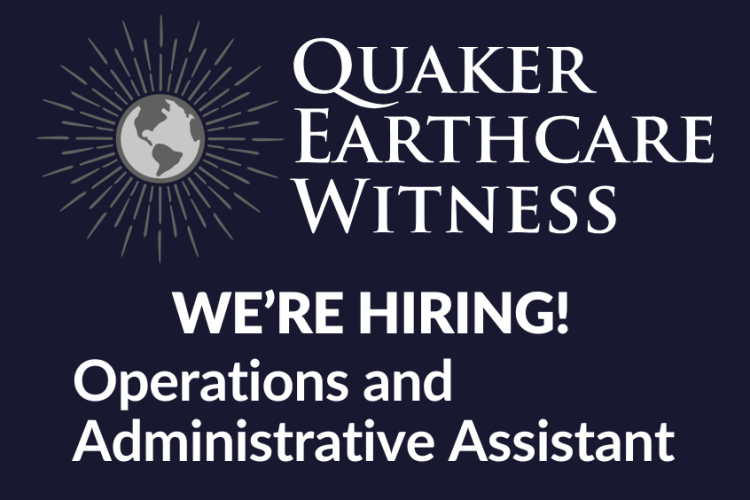An Experience in Lima: The UN Climate Change Conference

This December, Jonathan Woolley, the Director of Quaker UN Office (QUNO) Geneva, and I travelled to Lima to attend the latest round of international negotiations held under the UN Framework Convention on Climate Change (UNFCCC). These talks are working toward December 2015, when negotiators will gather in Paris to adopt a new, legally binding climate change agreement that will apply to all countries.
WHAT IS A COP?
The Conference of Parties (COP) and the Conference of the Parties serving as the meeting of the Parties to the Kyoto Protocol (CMP) form the annual decision-making session for the UNFCCC. This session, the COP 20 and CMP 10, was attended by some 6,300 government officials, 4,000 UN, intergovernmental and civil society representatives, and 900 members of the media. It was an extraordinary and exhausting experience; and disturbing too, when tensions and mistrust countered progress on ensuring that the most vulnerable today and in future generations are spared from suffering the effects of catastrophic climate change.
THE FOCUS OF THE COP
The COP oversees a vast range of issues which seem to increase each year, making it difficult for a small country delegation, let alone a non-governmental organisation (NGO) like QUNO, to follow everything. This year, issues were organised primarily within three groups: the Subsidiary Body for Implementation (SBI), the Subsidiary Body for Scientific and Technological Advice (SBSTA), and the Ad Hoc Working Group on the Durban Platform for Enhanced Action (ADP). This third group was at the centre of a crisis, and its work the most relevant to the creation of a new climate change agreement.
But the COP is more than the negotiations. In one area, negotiators work painstakingly on acceptable language, while in another, intergovernmental and civil society organizations are sharing information, brainstorming new ideas, and building networks through a packed schedule of side events and press conferences, and among rows of information booths. Negotiators attend side events whenever possible and at times participate in their panels, but negotiation schedules are gruelling. In turn, registered civil society representatives can attend some (though not all) negotiation sessions, and NGO groups, such as those representing research, environment, gender, or business, are allowed to make brief statements only at certain times during the COP.
MOVING THROUGH CRISIS AND TOWARD SUCCESS
Negotiations at the COP in Lima were described frequently as “rushed.” The list of final SBI and SBSTA decisions was short on “decisions made,” and long on “no agreement has been reached.” However, the trust and confidence between countries was strengthened through the Adaptation Fund, where financial pledges surpassed the initial fundraising target, and the ground breaking Multilateral Assessment, during which 17 developed countries (known as Annex 1 countries) gave presentations on their greenhouse gas (GHG) emissions reduction progress and took quite often critical and blunt questions from all Parties, developed and developing.
In addition, confidence grew through the decision that the Executive Committee of the Warsaw International Mechanism for Loss and Damage (especially critical to countries already experiencing catastrophic climate change) would be fairly distributed between 10 developed and 10 developing countries, with a clear distribution of regions/needs in the latter.
Yet most attention and crises occurred in the ADP, which had to produce decisions in Lima for progress on work toward adopting a new climate change agreement in December 2015 in Paris. The ADP’s work also aims to increase pre-2020 efforts among developed countries, including GHG mitigation and support to adaptation needs in developing countries (including climate finance); strong leadership from developed countries is critical in gaining confidence within developing countries to support a new climate change agreement applicable to all countries.
Yet the ADP had been facing increasing tensions over the last year, and this atmosphere fed into Lima as negotiators faced the sensitive tasks of defining what exactly “intended nationally determined contributions” (INDCs) entailed, how these INDCs would be reported, alongside how pre-2020 (pre new climate agreement) mitigation and finance commitments from developed countries would be improved.
The concept of INDCs came from a last minute “huddle” of delegates at the COP 19 in Warsaw as a compromise to enable each country to set their own targets rather than having these targets defined internationally, by the UNFCCC or any other such body. Transparent, fair, verifiable and legally binding INDCs from all countries could enable the global community to close the GHG emissions gap, so that we can keep global temperature rises to 1.5° or 2°C above pre-industrial levels. At the moment, current global emissions have risen higher since 2010 than ever before, placing us on track for up to a 4.8°C global mean temperature rise by 2081 (compared to 1986–2005 temperatures), an unprecedented rate of temperature rise that will have catastrophic consequences on the ability of human beings to thrive on the planet.
In Lima, there were disturbing exchanges in the first week of the ADP which continued to undermine trust and confidence. By the second week, the “draft text” was finally opened for negotiation and grew to some 58 pages of options, which was then deemed too unwieldy to reach consensus in the remaining negotiation time. The Co-Chairs then replaced this with a “bare bones” draft of four core pages, which caused profound concern particularly among developing countries. Unable after long night sessions to establish the consensus necessary for a decision, the Co-Chairs handed authority to the COP President, Manuel Pulgar-Vidal, who then worked around the clock with Parties. These efforts reintroduced assurances which went missing from the Co-Chairs’ “bare bones” text, yet were critical for consensus. These included: acceptance of a more balanced approach to mitigation and adaptation action, specific references to the Loss and Damage Mechanism, specific reference to climate science including the need for the global temperature increase to be limited to 1.5-2°C, and clearer reference to the principles of the UNFCCC Convention.
The time spent reclaiming “red line” assurances from negotiation groups meant that any goodwill needed to gain traction for a strong INDC reporting system, supported by developed but not all developing country parties, was weakened. So too were the issues for which many NGOs had worked hard to gain political support; for example, reference to human rights, the influence of climate justice, and recognition of zero carbon emissions by 2050 or 2100 (note: not zero net carbon emissions, which implies off-setting and carbon capture to maintain use of fossil fuels).
Yet Lima ended with some successes. First, the negotiation crisis went from outright rejections of the text by well over half of the 190 countries to consensus with all. Second, the crisis made clear that “differentiation” (what is a fair distribution of responsibilities between countries) and climate finance must be clarified if Paris is to succeed with a new universal climate change agreement.
It is easy to feel outrage when what is at stake is the ability of the most vulnerable today and in the future to avoid global catastrophic climate change. But it is less easy to be a champion delegate or delegation that courageously seeks to build bridges. Champions are those who publicly recognise the others’ concerns, who seek to better understand rather than ignore the fears feeding reactions around them. We seek this from our decisionmakers—taking responsibility for action within our own lives, while in turn asking them to take responsibility and lead with courage in supporting a fair and sufficient agreement for all. This would reflect the extraordinary energies in 2014, a year which saw, among other actions, the publication of the most comprehensive climate science to date through the Intergovernmental Panel on Climate Change (IPCC) 5th Assessment Report, the UN Climate Change Summit in New York alongside more than 2,800 climate change awareness events in a reported 166 countries, the most ambitious EU targets yet to mitigate GHG emissions, and a political breakthrough between China and the U.S. on proposed emission reduction action.
WHAT IS NEEDED?
For the poorest and the most vulnerable who see their very survival threatened now by climate change, the negotiations are a profound moral call to conscience. But for many, the primary political direction from governments through their negotiators is to protect their country’s economic development and competition, which most often is dependent on fossil fuels. And 78 percent of current temperature warming is due to the combustion of fossil fuels.
The climate change negotiations are primarily about current and future economic competition, not about the environment. As long as this remains the priority of nations, it is difficult for negotiators to move from “how does this affect us?” to “how does this affect others?”. The abolition of slavery in the 1800s became possible when the narrative moved from an economic to a moral one. We aspire to this narrative shift in the climate change negotiations, to enable the global community to speak for humanity.
Through the initial support of QEW, QUNO has been observing negotiations sessions at the United Nations Framework Convention on Climate Change (UNFCCC) since 2012. In 2013, QUNO initiated “quiet diplomacy” efforts in the form of off-the-record dinners during negotiation sessions (though not at the COP 20) to give space for more sincere and open discussion between a diverse group of negotiators. This work continues.
Lindsey Fielder Cook
Representative on Climate Change
Quaker United Nations Office, Geneva

